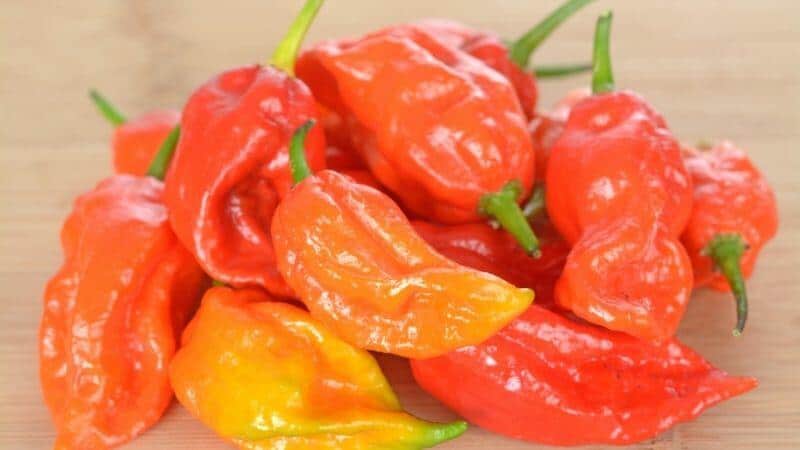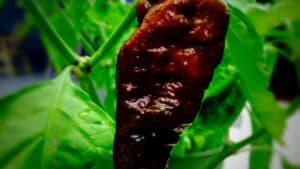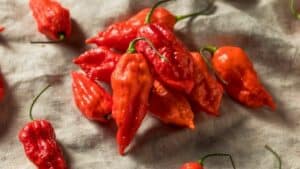Ghost peppers pack some serious heat. Their extreme spiciness makes some say they “stink.” But do these iconic chilis actually smell bad?
The answer is no – ghost peppers don’t truly stink. Their intense flavor comes from an odorless compound called capsaicin. This chemical triggers our senses in unique ways, giving ghost peppers an ultra-pungent essence that’s often mislabeled as “stinky.”
This article will explore the science behind ghost pepper pungency. You’ll learn:
- Why “stink” is the wrong term
- How capsaicin affects smell and taste
- If eating ghost peppers makes you smell
- Health benefits of capsaicin
- And more!
By understanding the biology behind this super-hot pepper, you can better appreciate its formidable yet flavorful punch. So let’s delve into why ghost peppers don’t actually stink!
Do Ghost Peppers Really Stink?
Ghost peppers don’t actually stink. They don’t give off a foul, rotten smell.
Instead, their kick comes from a chemical called capsaicin. This odorless compound gives ghost peppers their trademark heat.
Capsaicin creates an intense flavor. But since it has no scent, the chili itself is odorless.
Ghost peppers take on the smells of their environment, like the food they’re cooked with. The capsacin simply adds
So why do people say they stink? It’s likely just a strong reaction to their extreme pungency.
Why “Stink” Is the Wrong Word
Calling ghost peppers smelly is incorrect. But their power demands a description beyond normal “spicy.”
“Pungent” captures the essence better than “stinky.”
Per Merriam-Webster, pungent means:
- Having a sharp taste or smell
- Causing a sharp or irritating sensation
Spices like chili peppers trigger our senses in unique ways. Their phytochemicals cause a burning, tingling feeling by stimulating nerves and taste buds simultaneously.
This blending of sensations is why tastes like ghost pepper are called pungent. The term acknowledges their one-of-a-kind punch.
How Capsaicin Affects Smell and Taste
Capsaicin is the key compound that makes ghost peppers pungent.
When eaten, capsaicin interacts with special receptors in the mouth and nose called TRP ion channels. It activates the TRPV1 receptor to signal pain and heat.
This triggers nerves that carry burning and spicy sensations to the brain all at once. The combination of nerve and taste bud stimulation produces the intense pungency people describe as “stinky.”
Here’s how other spicy foods create pungency:
- Black pepper – Activates piperine
- Wasabi – Allyl isothiocyanate
- Garlic – Thiosulfinates
So ghost pepper pungency stems from a scientific reaction, not a foul odor.
Will Eating Ghost Peppers Make You Smell?
Eating ghost peppers won’t make you stink.
Foods like garlic and curry can cause body odor as their smelly compounds release through skin. But that doesn’t happen with odorless capsaicin.
Some people may sweat more after eating spicy ghost peppers. But this flush doesn’t cause lasting bad smells.
Proper hygiene and showering after consuming chilis prevents any temporary scent.
The Benefits of Capsaicin
While an unpleasant experience for many, capsaicin offers health benefits:
- Pain relief – Creams use extracted capsaicin to soothe arthritis, shingles, and neuropathy pain when applied topically.
- Weight loss – Research shows capsaicin can boost metabolism, increasing fat burn.
- Anti-cancer – Studies are examining capsaicin’s potential to fight cancer by inhibiting cell growth.
- Antimicrobial – Capsaicin shows promise killing bacteria like E. coli and S. aureus.
So despite the pungency, capsaicin and ghost peppers have therapeutic potential.
Frequently Asked Questions
Do rotten ghost peppers stink?
Yes, rotten ghost peppers eventually stink. Decay causes biological components to break down, releasing foul odors. But fresh ghost peppers themselves have no scent.
Do ghost peppers have any smell?
Not exactly. We register their capsacin as sensations in the nose and throat. But there is no true “smell” to fresh ghost peppers.
Why is ghost pepper scent described as pungent?
Since odorless capsaicin causes a strong nasal and mouth feel, “pungent” conveys the unique peppery sensation better than terms like “stinky.”
The Takeaway
Ghost peppers don’t actually stink or have a funky smell. The feeling of their
While certainly intense, the chili’s capsacin offers unique flavor along with health benefits. Understanding the science helps appreciate this iconic pepper.





